Personal Wealth Management / Market Analysis
Five Fallacies About “Overvalued” Stocks
P/E ratios and other valuations are overrated, not overvalued.
Death and taxes might be life's only certainties, but one of this bull market's trends gives them a run for their money: As soon as stocks hit a record high, pundits start warning of "too-high" valuations and imminent malaise. They're doing it now, on the heels of Friday's fantastically arbitrary milestone, the first simultaneous record high in the S&P 500, Dow and Nasdaq since 1999. Some point to traditional P/E ratios, some to the ever-trendy cyclically adjusted P/E (CAPE), and some to less splashy metrics like price-to-book ratios. All make the same error: presuming the past predicts the future. And all who heed their warnings make another error: confusing fact with opinion. Yes, "stocks are overvalued" is an opinion, based on one interpretation of some numbers. Stocks discount all widely known information, including widely held opinions, and often surprise everyone by defying them.
Contrary to popular myth, no level of valuation is inherently too low, too high or just right. Many presume a given metric's long-term average is "just right," but that is just wrong. Sorry. Historical averages can help you put today's valuations in context, but they are not some mean today's valuations must revert to. For stock prices, there is no such thing as fair value. Stocks' value is always and everywhere what investors are willing to pay for them.
As the next few charts show, no valuation today is wildly out of kilter with its long-term average. That, on its own, doesn't mean stocks aren't overvalued. But if you view valuations as a sentiment indicator, as we do, it does suggest we haven't yet seen the runaway increase in confidence that typically marks a bull market's peak. Valuations' modest drift higher is mostly consistent with the gradually improving sentiment that's typical of maturing bull markets.
Exhibit 1: S&P 500 Forward P/E Ratio
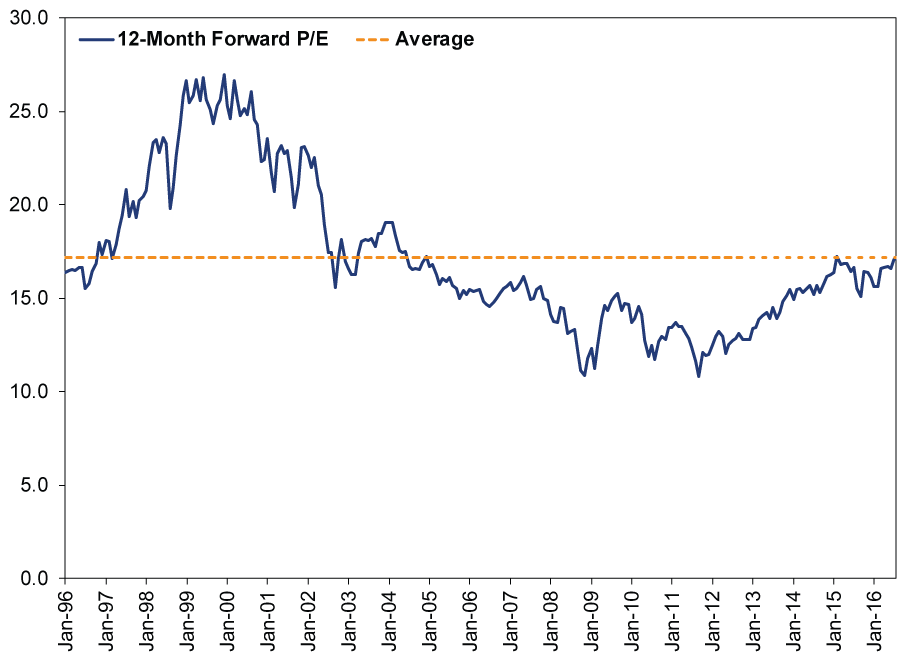
Source: FactSet, as of 8/15/2016. S&P 500 Forward P/E, monthly, 1/31/1996 - 8/12/2016.
Exhibit 2: S&P 500 Trailing P/E Ratio
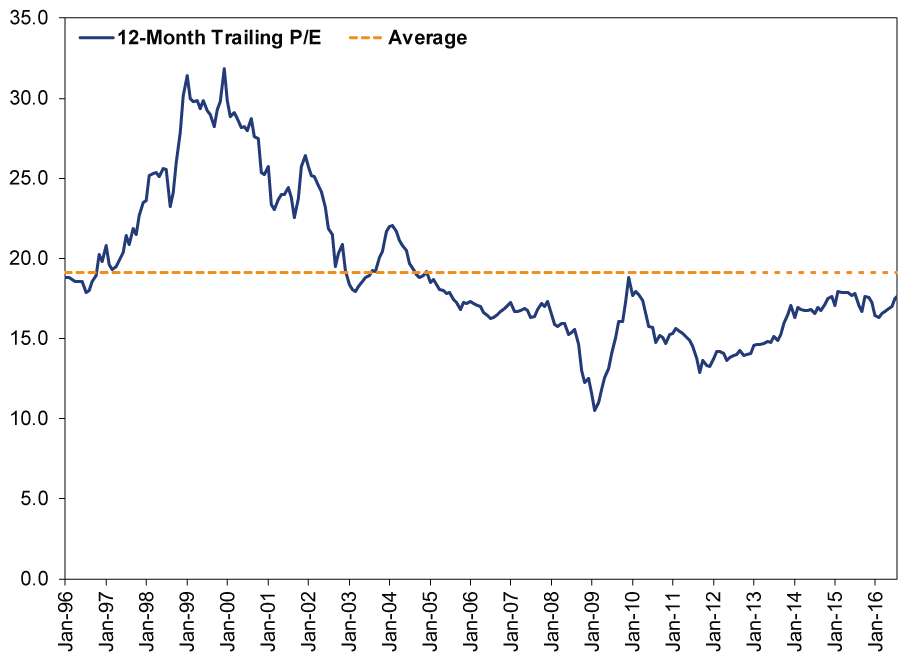
Source: FactSet, as of 8/15/2016. S&P 500 Trailing P/E, monthly, 1/31/1996 - 8/12/2016.
Exhibit 3: S&P 500 Price-to-Book Ratio
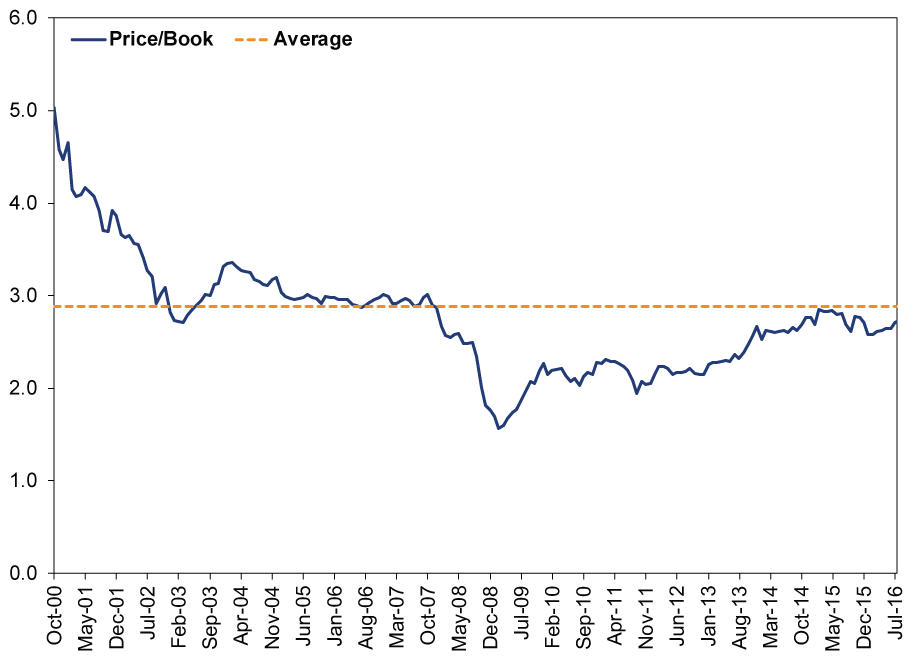
Source: FactSet, as of 8/15/2016. S&P 500 P/B, monthly, 10/31/2000 - 8/12/2016.
Exhibit 4: S&P 500 Price-to-Sales Ratio
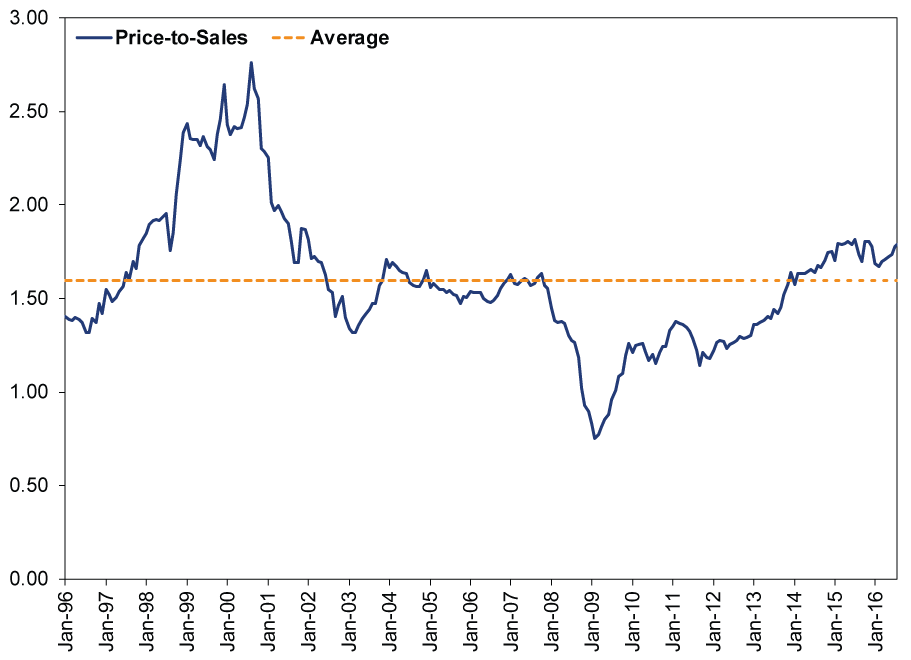
Source: FactSet, as of 8/15/2016. S&P 500 P/S, monthly, 1/31/1996 - 8/12/2016.
We excluded CAPE from this series because-unlike traditional valuations-it doesn't even measure sentiment. It is a bizarrely inflation-adjusted backward-looking mess of a thing, comparing a stock's price to the last 10 years' earnings. This calculation purports to remove cyclical skew-or, in less jargon-packed terms, it cancels out earnings' recessionary lows with their expansionary highs. In reality, all it does is overemphasize the distant past-irrelevant today-while ignoring the future. Stocks' earnings in late 2006 have no bearing on what their price should be today. Nor do they predict future earnings. CAPE gets heaps of attention because it spiked before the tech bubble burst and before 1929's crash, but you know what they say about broken clocks. It misfired plenty in the intervening years, including in 1996, when its co-creator said it signaled "irrational exuberance." Heeding CAPE was the wrong move then, and we suspect it is the wrong move now.
But we digress. As mentioned a couple paragraphs ago, what rising valuations signal is a matter of opinion. Our opinion, as you likely gleaned, is that they signal modest improvements in sentiment. Ours is not a very popular opinion-more popular is the "eek that's too high" opinion. When confronted with opinions counter to our own, we think it's wisest to test them against simple logic.
What fallacies might those who say high valuations = overvalued stocks be committing? Welp, there are a few:
- Presuming past performance predicts future returns
- Presuming stocks and earnings must revert to the mean
- Presuming laws of physics apply to markets, which are decidedly not physical objects
- Equivocating-defining "overvalued" as necessary to prove the point at this moment. For instance, why should anyone truly think a trailing P/E ratio at 17.6 today is overvalued when December 2009's 18.8 P/E was clearly not overvalued? If the comparison depends on what the meaning of the word overvalued is, that is not a valid comparison. Opinion, not science.
- Presuming "cheap" means stocks are more desirable. This is a bias drawn from the "value" school of investing. It is, of course, sometimes true. But in this bull market, growth stocks-those with higher valuations-have outperformed, and fairly significantly in the last two years. (Exhibit 5)
Exhibit 5: Pricier "Growth" Stocks Have Beaten Cheaper "Value" Stocks
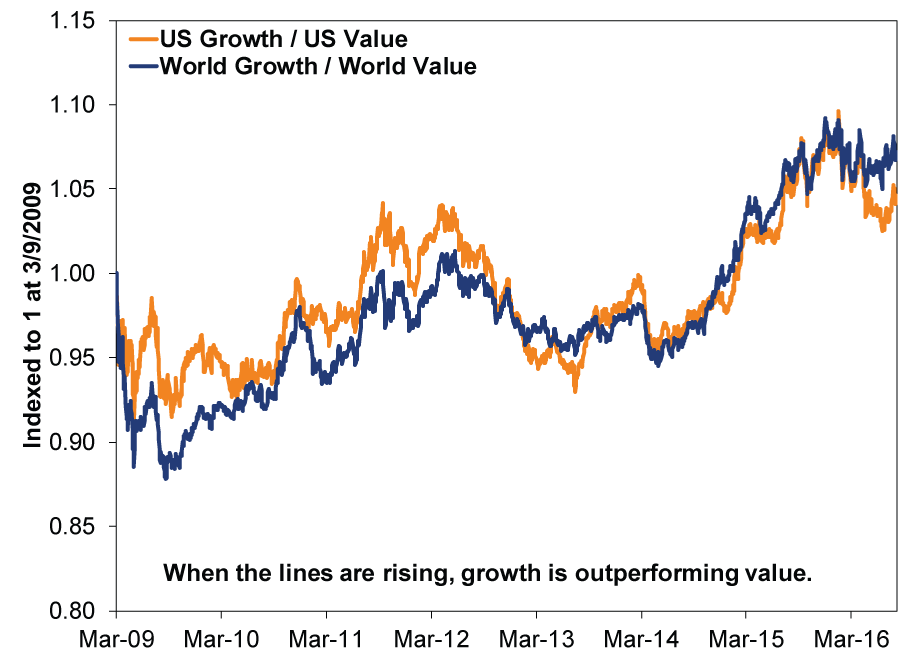
Source: FactSet, as of 8/16/2016. US is represented by the Russell 1000 Growth Index divided by the Russell 1000 Value Index, both including gross dividends. World is represented by the MSCI World Growth Index dividend by the MSCI World Value Index, both including net dividends, 3/9/2009 - 8/15/2016.
We'd suggest not overthinking valuations or any one metric. Hard as it might be to do in this data-obsessed world, think qualitatively. Saying the market is overvalued implies investors are paying too much for too little. When you buy a stock, you buy a share in that company's future earnings. There are plenty of reasons to believe there will be more of those future earnings than most believe today. Overall and on average, expectations are low, judging from the steady deterioration in analyst estimates as tallied by the good folks at FactSet. People keep reducing their forecasts, setting the bar lower. Those dreary expectations are baked into today's stock prices. In other words, investors are paying wee premium for what most expect to be rather lackluster profits.
But what if reality exceeds expectations? Maybe it will turn out investors today bought at a discount! We think there is a strong chance this turns out to be the case. The global economy is growing, which means demand for publicly traded firms' goods and services is growing. Lending and broad money supply are growing nicely in much of the world, giving consumers and businesses alike more spending fuel. Most leading indicators (particularly The Conference Board's set) point positively. Most of the financial press overlooks these points, instead dwelling on long-running sore spots like Brazil and Italian banks or the occasional weak economic report, like US retail sales last Friday. They read too much into waning US productivity, presuming earnings can't rise if companies don't indirectly cut costs by making efficiency gains-and in doing so, they completely ignore the potential for rising demand to boost sales and earnings.
Not that we're calling stocks "undervalued." We're mostly inclined to do away with labels like that entirely, because they lead investors to a weird place. Keep it simple: Is this a bull market, or are we heading into a bear market? Based on everything we just wrote, we think this is a bull market, and it appears poised to run for the foreseeable future. That makes this a time to own stocks, in our view, regardless of where valuations are and how others interpret them.
If you would like to contact the editors responsible for this article, please message MarketMinder directly.
*The content contained in this article represents only the opinions and viewpoints of the Fisher Investments editorial staff.
Get a weekly roundup of our market insights
Sign up for our weekly e-mail newsletter.

You Imagine Your Future. We Help You Get There.
Are you ready to start your journey to a better financial future?

Where Might the Market Go Next?
Confidently tackle the market’s ups and downs with independent research and analysis that tells you where we think stocks are headed—and why.





